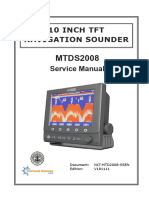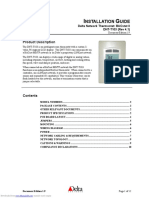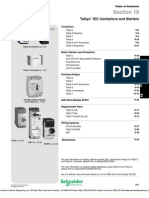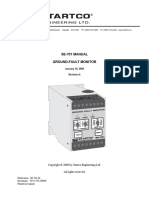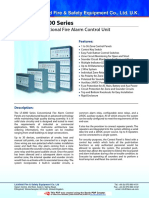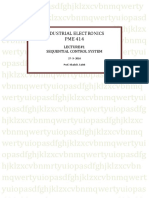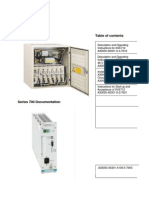TAC Xenta® 491/492
TAC Xenta® 491/492
Uploaded by
SswahyudiCopyright:
Available Formats
TAC Xenta® 491/492
TAC Xenta® 491/492
Uploaded by
SswahyudiCopyright
Available Formats
Share this document
Did you find this document useful?
Is this content inappropriate?
Copyright:
Available Formats
TAC Xenta® 491/492
TAC Xenta® 491/492
Uploaded by
SswahyudiCopyright:
Available Formats
TAC Xenta® 491/492
Analog Output Modules 4 Sep 2002
TAC Xenta 491 and 492 are Analog Output modules in the If there are several controllers and I/O modules in the same
TAC Xenta family. They are used as expansion modules for network, a special Device Configuration Tool PC program
the TAC Xenta controllers, connected by the common is used during installation.
network. The input/output status can be checked from the TAC Xenta
Both modules have eight analog outputs. OP operator panel connected to any TAC Xenta controller
In addition, TAC Xenta 492 is equipped with manual override in the same network.
for the analog output values. TAC Xenta OP has a display and a minimum number of
TAC Xenta 491/492 is associated with a specific controller push buttons.
with the assistance of the TAC Menta graphical tool.
TECHNICAL DATA
Supply voltage ............................. 24 V AC ±20%, 50/60 Hz mm (in.):
90 (3.5)
or 19–40 V DC
2 3 4 5 6 7 8 10
Ø 4 (0.2)
Power consumption .............................................. max. 2 W
Transformer sizing ........................................................ 3 VA
Ambient temperature:
110 (4.3)
45 (1.8)
48 (1.9)
Storage .................................... -20 to 50 °C (-4 to 122 °F)
Operation ................................... 0 to 50 °C (32 to 122 °F)
Humidity .............................. max. 90% RH non-condensing
Mechanical: 12 13 14 15 16 17 18 20
Enclosure ............................................................. ABS/PC 10.1 70 (2.8) 75 (3.1)
(0.4)
Enclosure rating ........................................................ IP 20
Dimensions ................................................... see diagram Agency Compliances:
Weight ..................................................... 0.4 kg (0.88 lbs) Emission ...................... C-Tick, EN 50081-1, FCC Part 15
Immunity ........................................................ EN 50082-1
Analog outputs (Y1–Y8): Safety:
Quantity .......................................................................... 8 CE ............................................................. EN 61010-1
Control voltage ................................................ 0–10 V DC UL 916 ...................... Energy Management Equipment
Control current, short-circuit proof ................... max. 2 mA ETL listing ................................ UL 3111-1, first edition
Deviation .............................................................. max 1% ................................... CAN/CSA C22.2 No. 1010.1-92
Manual override for analog outputs (TAC Xenta 492 only): Flammability class, materials ....................... UL 94 V-0
Quantity .......................................................................... 8 Part numbers:
Switch positions ............................................ MAN, AUTO Electronics part TAC Xenta 491 ..................... 0-073-0301
Potentiometer range ............................................... 0-10 V Electronics part TAC Xenta 492
Communication: (with Analog Output override) ................. 0-073-0303
Network .............. Echelon LONWORKS® TP/FT-10, 78 kbps Terminal part TAC Xenta 400 ......................... 0-073-0902
Subject to modification. 1 (2) 0-003-1927-1 (EN)
DESIGN
TAC Xenta 491/492 consists of a terminal
and circuit board mounted together (fig-
ure 1). All terminations of field wires are
made to the terminal part only. Thus, the
electronics may be removed for service
without affecting the terminal connections.
Analog Outputs
There are eight Analog Outputs to control
actuators and the connection to control-
lers. No external power supply is required. Figure 1
Furthermore, TAC Xenta 492 is equipped
with eight switches to manually override LED indicators lights up if there is a hardware fault. The
the analog outputs. In the MAN case a There are two general LED indicators on other is green and blinks to indicate that
value 0-10 V is set with a potentiometer. the front of the module. One is red and the application program is running.
MOUNTING CABLES
TAC Xenta 491/492 is cabinet mounted G and G0: For other applications, please refer to
on a TS 35 mm norm rail EN 50022. The Min. wire size of 0.75 mm2 (19 AWG). the TAC Xenta Network guide.
module consists of two parts: a terminal C1 and C2: The wires are polarity insensitive, but
with screw terminals, and electronics with The TP/FT-10, 78 system allows the must be a twisted-pair.
circuit boards. To simplify installation, the user to wire the control devices with
Terminals Y1–Y8:
terminal part can be pre-mounted on the virtually no topology restrictions. The
Min. cross-sectional area 0.25 to
cabinet (see figure 1). max. wire distance in one segment
0.75 mm2 (18 to 22 AWG).
If the module is wall mounted, a wide depends on the type of wire and the
Max. cable length 20 to 200 m
range of standardized boxes are avail- topology. For normal applications,
(65 to 650 ft.).
able. using the Belden 85102 cable, the
(please refer to the TAC Xenta 400
distance may be up to 500 m (1640 ft.).
I/O modules manual for details).
INSTALLATION
There is a label on the front of the module Terminal connections
with both the numbers and the names of Term. Term. Description Term. Term. Description
the terminals (1 C1, 2 C2 and so on). The no. name no. name
numbers are also shown in the plastic of 1 G 24 V AC/DC 11 Y4 Analog output 0-10 V
the terminal part. 2 G0 } 12
13
M
Y5
Output neutral
Analog output 0-10 V
3 C1 LONWORKS
Service pin
To simplify network commissioning, there 4 C2 } TP/FT-10, 78 kbps 14
15
M
Y6
Output neutral
Analog output 0-10 V
is a service pin on the electronic unit 5 Y1 Analog output 0-10 V
6 M Output neutral 16 M Output neutral
which, when pressed, identifies the unit 17 Y7 Analog output 0-10 V
on the network. 7 Y2 Analog output 0-10 V
8 M Output neutral 18 M Output neutral
If the pin is pressed continuously for more 19 Y8 Analog output 0-10 V
9 Y3 Analog output 0-10 V
than seven seconds within 60 seconds 20 M Output neutral
10 M Output neutral
after a restart, all values of the unit will be
reset to the default values.
The unique Neuron ID is printed on a label
on the rear of the unit.
COMMUNICATION MAINTENANCE
LONWORKS connection The additional I/O units also connect to Keep the module dry and clean it exter-
TAC Xenta 300/400 controllers and I/O- the network and may be added as re- nally with a dry cloth when needed.
modules communicate with each other quired. An I/O unit can only be associated
using a common bus, Echelon LONWORKS® with one controller.
TP/FT-10, Free Topology, 78 kbps. A The LONTALK® protocol makes it possible
number of controllers can form a network to use Network Variables (NVs; for ex-
and exchange data. ample I/O values) defined in foreign equip-
ment.
TAC and TAC products are trademarks and/or registered trademarks of TAC AB.
All other trademarks belong to their respective owners. Copyright 2002 TAC AB. All rights reserved.
tac-global.com
0-003-1927-1 (EN) 2 (2)
You might also like
- 16 - VT100 - 110 - 2x0 - 4x0 - InstallationDocument64 pages16 - VT100 - 110 - 2x0 - 4x0 - Installationsky_lord100% (1)
- dgc1000 Manual PDFDocument133 pagesdgc1000 Manual PDFBrianHazeNo ratings yet
- Bigtreetech Manta m8p v2.0 User ManualDocument37 pagesBigtreetech Manta m8p v2.0 User ManualKrug See100% (1)
- ZAPI AC-0 ManualDocument62 pagesZAPI AC-0 ManualRizki Febri80% (5)
- Raytheon Anschutz DISTRIBUTION UNIT COMPACT Type 138-126Document32 pagesRaytheon Anschutz DISTRIBUTION UNIT COMPACT Type 138-126smartstep100% (6)
- MEX816UDocument19 pagesMEX816USergeyNo ratings yet
- ZAPI AC-1 ManualDocument62 pagesZAPI AC-1 ManualMarcos Gregorio da SilvaNo ratings yet
- 700 Series SubZero Service and PartsDocument92 pages700 Series SubZero Service and PartsKale Arbrough100% (3)
- TAC Xenta 451/452: Analog Input and Output Module 4 Sep 2002Document2 pagesTAC Xenta 451/452: Analog Input and Output Module 4 Sep 2002NATHANNo ratings yet
- TAC Xenta 411/412: Digital Input Module 29 Aug 2002Document2 pagesTAC Xenta 411/412: Digital Input Module 29 Aug 2002NATHANNo ratings yet
- TAC Xenta 451A/452A: Universal Input and Analog Output Module 13 Oct 2004Document4 pagesTAC Xenta 451A/452A: Universal Input and Analog Output Module 13 Oct 2004Jose sanchezNo ratings yet
- TAC Xenta 421A/422A: Universal Input and Digital Output ModuleDocument5 pagesTAC Xenta 421A/422A: Universal Input and Digital Output ModuleJose sanchezNo ratings yet
- TAC Xenta 300: Programmable Controller 11 Aug 2003Document4 pagesTAC Xenta 300: Programmable Controller 11 Aug 2003NATHANNo ratings yet
- Tac ControllerDocument4 pagesTac ControllerArvind NangareNo ratings yet
- 324 Cordex 125 220VDC 1 1kW Data SheetDocument2 pages324 Cordex 125 220VDC 1 1kW Data Sheetibs434No ratings yet
- TAC Xenta® 451A/452A: Universal Input and Analog Output ModuleDocument4 pagesTAC Xenta® 451A/452A: Universal Input and Analog Output Moduleomer maalyNo ratings yet
- Rtaa Controls-12 Rtaa Controls-12 Upgrade UpgradeDocument12 pagesRtaa Controls-12 Rtaa Controls-12 Upgrade UpgradeavtotestNo ratings yet
- Inverter 2000 Rev DDocument2 pagesInverter 2000 Rev DdiabolousxNo ratings yet
- ATI FT CatalogDocument42 pagesATI FT CatalogAgenor BarbosaNo ratings yet
- Mitubishi AirCon TechManual DXK32ZL SDocument92 pagesMitubishi AirCon TechManual DXK32ZL Scraig027No ratings yet
- TAC Xenta 280: Programmable Controller 2 Mar 2005Document4 pagesTAC Xenta 280: Programmable Controller 2 Mar 2005Mario PuceljNo ratings yet
- 2-Wire Transmitter With HART Protocol: ApplicationDocument2 pages2-Wire Transmitter With HART Protocol: Applicationcoronel_goNo ratings yet
- Cordex 3.1kW: 24Vdc Modular Switched Mode RectifierDocument2 pagesCordex 3.1kW: 24Vdc Modular Switched Mode RectifierwilsonNo ratings yet
- User's Manual: Easergy RangeDocument96 pagesUser's Manual: Easergy Rangexor_45No ratings yet
- Cordex CXCIDocument2 pagesCordex CXCIibs434No ratings yet
- Cordex400Wr 10 - D04Document2 pagesCordex400Wr 10 - D04jimmy torresNo ratings yet
- Slyy 016 ADocument37 pagesSlyy 016 AJoseph RogersNo ratings yet
- Powerview: Model Pv380 R3 Installation ManualDocument9 pagesPowerview: Model Pv380 R3 Installation ManualВладислав ВиршинитNo ratings yet
- MEx 48 UDocument21 pagesMEx 48 URichard AntonioNo ratings yet
- 4511 19049 UsDocument2 pages4511 19049 UsOvidiu RaicovNo ratings yet
- 03-00046-02 TAC-Xenta-711-731 - Data-Sheet - TAC-Xenta-700-5.1.1-EN PDFDocument6 pages03-00046-02 TAC-Xenta-711-731 - Data-Sheet - TAC-Xenta-700-5.1.1-EN PDFhoahoangNo ratings yet
- Controllers For BD Compressors: Operating Instructions (BD P-Housing)Document36 pagesControllers For BD Compressors: Operating Instructions (BD P-Housing)李江No ratings yet
- ATI FT Sensor Catalog 2005Document32 pagesATI FT Sensor Catalog 2005set_ltdaNo ratings yet
- VLT5000Document2 pagesVLT5000harrysmith2No ratings yet
- KXseries User enDocument24 pagesKXseries User enAhmed Jihed SassiNo ratings yet
- MTDS2008 Service Manual V181111Document26 pagesMTDS2008 Service Manual V181111kamin.92No ratings yet
- Cordex - CXCR - CXCP - Rev ADocument2 pagesCordex - CXCR - CXCP - Rev AJOEY MONTAÑONo ratings yet
- EtherCat and Ethernat ManualDocument53 pagesEtherCat and Ethernat Manualsven.garcia1979No ratings yet
- MEX816 UDocument22 pagesMEX816 URichard AntonioNo ratings yet
- ' LCD TVDocument62 pages' LCD TVSantiago CandoNo ratings yet
- Added and Changed Features For Installation Manual and Programming Tables Vol. 3Document90 pagesAdded and Changed Features For Installation Manual and Programming Tables Vol. 3Ez az én nevemNo ratings yet
- UC8 Troubleshooting Guide v2 0715Document24 pagesUC8 Troubleshooting Guide v2 0715Thom ReynoldsNo ratings yet
- Description: 40 V, 3.5 A Quad Power Half-BridgeDocument21 pagesDescription: 40 V, 3.5 A Quad Power Half-BridgedinnhowNo ratings yet
- Control Panel TE805 Data SheetDocument5 pagesControl Panel TE805 Data SheetCalixte Gbaguidi100% (1)
- Service Manual Acer Travel Mate 4210 4270 4670 Aspire 5620 5670Document132 pagesService Manual Acer Travel Mate 4210 4270 4670 Aspire 5620 5670Soporte Tecnico Buenos AiresNo ratings yet
- 271.123 - 856.BGE Diesel Management Unit, DMU 10 DSM 402Document12 pages271.123 - 856.BGE Diesel Management Unit, DMU 10 DSM 402aaronNo ratings yet
- Infineon FF450R17ME7 - B11 DataSheet v01 - 00 ENDocument17 pagesInfineon FF450R17ME7 - B11 DataSheet v01 - 00 ENHải Nguyễn hồngNo ratings yet
- Krc2 Perifery enDocument21 pagesKrc2 Perifery enOkoNo ratings yet
- 015467F Natus Quantum Amp Spec FNLDocument1 page015467F Natus Quantum Amp Spec FNLmotan00No ratings yet
- Res-440 eDocument89 pagesRes-440 ePedro Luiz PráNo ratings yet
- Sanyo CM29FS2 FB1B PDFDocument41 pagesSanyo CM29FS2 FB1B PDFJerald D'costaNo ratings yet
- Tetrode ManualDocument50 pagesTetrode ManualDragan AntonićNo ratings yet
- ZAPI AC-0 Manual Carretillas EPDocument62 pagesZAPI AC-0 Manual Carretillas EPRicardo Gamez Ortega50% (2)
- Ad2083-Rs422-Distributor Ds A4 enDocument2 pagesAd2083-Rs422-Distributor Ds A4 enmoscuNo ratings yet
- 7805 Regulator DescriptionDocument4 pages7805 Regulator DescriptionyeateshwarriorNo ratings yet
- Hfe Yamaha Rx-E410 E810 ServiceDocument57 pagesHfe Yamaha Rx-E410 E810 ServiceYoly Rio RamosNo ratings yet
- Galcon Manual UsuarioDocument65 pagesGalcon Manual Usuariopedro1981No ratings yet
- DNTT 103Document12 pagesDNTT 103nhiahm nhiahmNo ratings yet
- Radio Shack TRS-80 Expansion Interface: Operator's Manual: Catalog Numbers: 26-1140, 26-1141, 26-1142From EverandRadio Shack TRS-80 Expansion Interface: Operator's Manual: Catalog Numbers: 26-1140, 26-1141, 26-1142No ratings yet
- PCV 02Document1 pagePCV 02SswahyudiNo ratings yet
- BOLOK Thermodynamic Characteristic Curves of Condensing TurbineDocument19 pagesBOLOK Thermodynamic Characteristic Curves of Condensing TurbineSswahyudiNo ratings yet
- Electric Valve Actuator (DZW)Document14 pagesElectric Valve Actuator (DZW)Sswahyudi100% (1)
- Instruments Index RO Plant YTMDocument8 pagesInstruments Index RO Plant YTMSswahyudiNo ratings yet
- CuprionDocument93 pagesCuprionSswahyudiNo ratings yet
- PL O Tfqdu - Ot : L"Dcoej, Q ) S?: Po P./JDocument14 pagesPL O Tfqdu - Ot : L"Dcoej, Q ) S?: Po P./JSswahyudiNo ratings yet
- Manual Book TurbinDocument130 pagesManual Book TurbinSswahyudiNo ratings yet
- Tnu TT 10 Pro DWG 003 AllDocument9 pagesTnu TT 10 Pro DWG 003 AllSswahyudiNo ratings yet
- Basic Design and Engineering Package PDFDocument164 pagesBasic Design and Engineering Package PDFSswahyudi100% (6)
- Digest SchaniderDocument56 pagesDigest SchaniderSaka AdityaNo ratings yet
- Catalog PDFDocument85 pagesCatalog PDFSswahyudiNo ratings yet
- A2 - Open, Pre Cabled Motor Starters - P - EN (Dgcat)Document22 pagesA2 - Open, Pre Cabled Motor Starters - P - EN (Dgcat)SswahyudiNo ratings yet
- ABB Thermal and Electronic Overload RelaysDocument40 pagesABB Thermal and Electronic Overload RelaysVicktor GranadosNo ratings yet
- F Rictional Head Loss Affecting Pipeline Diametre With Different MaterialDocument3 pagesF Rictional Head Loss Affecting Pipeline Diametre With Different MaterialSswahyudiNo ratings yet
- Research Article: Cathodic Protection of Pipeline Using Distributed Control SystemDocument8 pagesResearch Article: Cathodic Protection of Pipeline Using Distributed Control SystemSswahyudiNo ratings yet
- Module 3 Intro To ElectroPneumaticsDocument8 pagesModule 3 Intro To ElectroPneumaticsIvy Totanes TaborNo ratings yet
- Finel Report of 1st TrainingDocument53 pagesFinel Report of 1st Trainingnadishan001No ratings yet
- Jumo Heattherm-At and Jumo Heattherm-Dr: Type 603070, Surface-Mounted or Room Thermostat VersionsDocument15 pagesJumo Heattherm-At and Jumo Heattherm-Dr: Type 603070, Surface-Mounted or Room Thermostat VersionsNORODDINENo ratings yet
- Mechatronics - UNIT1-FHDocument23 pagesMechatronics - UNIT1-FHsaba100% (3)
- Ground-Fault MonitorDocument16 pagesGround-Fault MonitorKamila WehbeNo ratings yet
- Design and Implementation of Motor Speed Control and Temperature Sensing Unit Using PIC ControllerDocument4 pagesDesign and Implementation of Motor Speed Control and Temperature Sensing Unit Using PIC ControllerAnthony Clark QuezadaNo ratings yet
- ESG2002 Controller PDFDocument15 pagesESG2002 Controller PDFAung Mh100% (1)
- LF-4000 Series: Conventional Fire Alarm Control UnitDocument43 pagesLF-4000 Series: Conventional Fire Alarm Control UnitRandy FajardoNo ratings yet
- Application of Electric and Electronic Drives in RoboticsDocument3 pagesApplication of Electric and Electronic Drives in RoboticsGilbert SigalaNo ratings yet
- AbrasiMatic300BrochureDocument8 pagesAbrasiMatic300BrochureTUXEDO TVNo ratings yet
- Finefocus 800: Instruction ManualDocument64 pagesFinefocus 800: Instruction ManualMURAT ORMANNo ratings yet
- PT-500 Operating-Instructions INT enDocument30 pagesPT-500 Operating-Instructions INT enkelvinnguyen1970No ratings yet
- FSD 4Document11 pagesFSD 4Vinit ShrivastavaNo ratings yet
- A Study On Customer Satisfaction Full ProjectDocument68 pagesA Study On Customer Satisfaction Full ProjectBlessy50% (2)
- Digistat 2RF - 3RF Installation InstructionsDocument11 pagesDigistat 2RF - 3RF Installation InstructionsMoath Mohamed DagamsehNo ratings yet
- General DescriptionDocument6 pagesGeneral DescriptiondjeisnerNo ratings yet
- Spacelabs 90217 Ambulatory Blood Pressure Monitor - Service ManualDocument62 pagesSpacelabs 90217 Ambulatory Blood Pressure Monitor - Service ManualsozuakNo ratings yet
- Industrial Electronics PME 414: Lecture#1 Sequential Control SystemDocument19 pagesIndustrial Electronics PME 414: Lecture#1 Sequential Control SystemOmar YehiaNo ratings yet
- DP 6900Document125 pagesDP 6900abeklNo ratings yet
- Electronic Control Module: Systems OperationDocument6 pagesElectronic Control Module: Systems Operationanak haruanNo ratings yet
- A30050 X6301 X100 5 76K5 PDFDocument72 pagesA30050 X6301 X100 5 76K5 PDFBossNo ratings yet
- TB01200003EDocument132 pagesTB01200003EJohn LorenzoNo ratings yet
- Operations, Service Manual & Parts List: ADU-42CF Portable Scrub SinkDocument24 pagesOperations, Service Manual & Parts List: ADU-42CF Portable Scrub Sinkjcgm2209No ratings yet
- Safe Working ProceduresDocument2 pagesSafe Working ProceduresSusan SeseNo ratings yet
- Genie CE HD Operator ManualDocument36 pagesGenie CE HD Operator ManualNestor Marquez-DiazNo ratings yet
- 312E, 312F, 313F, 316E, 316F, 318E, 318F, 320E, 320F, 323E, 323F, 325F, 335F, 336F, 340F, 349F, 352F, 374F and 390F Air Conditioning Excavator Electrical System, 372-9312-01 (M0097309)Document2 pages312E, 312F, 313F, 316E, 316F, 318E, 318F, 320E, 320F, 323E, 323F, 325F, 335F, 336F, 340F, 349F, 352F, 374F and 390F Air Conditioning Excavator Electrical System, 372-9312-01 (M0097309)Carlos MenaNo ratings yet
- 冷热饮机说明书(中性英文-A4) (2024-04-28 03 - 31 - 32)Document10 pages冷热饮机说明书(中性英文-A4) (2024-04-28 03 - 31 - 32)alboushi.trNo ratings yet



































